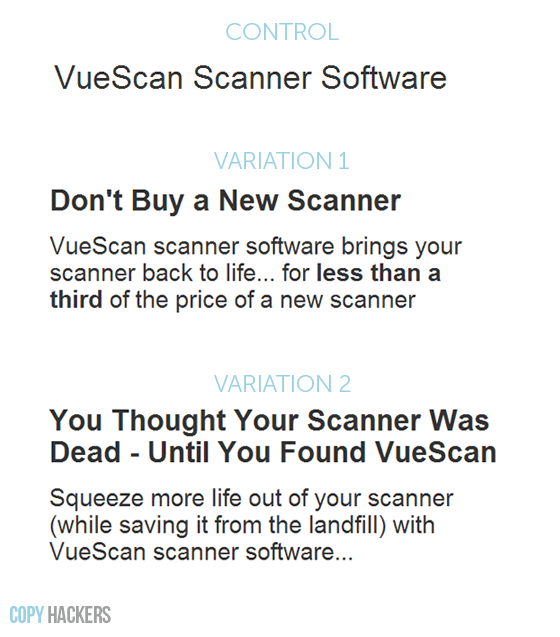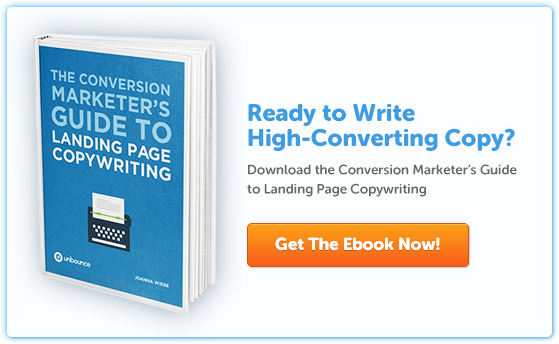
Why split test your landing pages?
Because you never know what impact a copy or design change might have on your business.
Why should you report on your test results?
Because sharing our successes and failures can help inform future optimization efforts. Test data can sometimes tell interesting stories worthy of addition to the canon of landing page “best practices.”
But if the growing body of A/B testing case studies can teach us anything, it’s that there’s no such thing as a “best practice” and that you’d be wise not to base your new landing page on what worked for someone else.
Disagree? Agree enthusiastically? Then you’ll definitely want to check out these three examples of landing page copywriting “best practice” fails…
So-called best practice #1: Never be clever
When writing copy for a landing page that will convert, the rule of thumb has been to write a clear message, not a clever one. Clarity trumps cleverness, right?
Not always.
When we tested clear, straightforward copy against clever copy, we were surprised by the results:
As you can see, we got nearly 18% more visitors to schedule an iPhone repair when we used a clever headline and subhead.
So does clarity always beat clever copy?
Evidently not. In this case, the clever message may have performed best because it more closely matched the conversation in the visitors’ heads at the moment they landed on the page. Perhaps the less formal language felt relatable and echoed the pain they were experiencing.
Rather than hatin’ on clever messaging, you might want to apply these better practices:
- Write the way your audience talks.
- Join the conversation already happening in their heads when they arrive on your landing page.
So-called best practice #2: Lead with the benefit
The prevailing wisdom is that people do not buy products – they buy solutions to their pain. They buy either painkillers or vitamins, as my friends Jack and Adii put it in this book.
As marketers, we take that wisdom and we try to turn it into repeatable tactics. We say that people always want benefits, not features, so we should never lead with features.
Talk about benefits first! Talk about a great outcome! Talk about value! Do NOT lead with a message about the product itself!
But is this always best for conversions?
We tested a rather bland product-focused headline against two headlines that better spoke to the value of the product and the reason to use it. Here are the three creative treatments we tested:

Which of those two variations do you think beat the control?
Take a look.
Consider them closely.
Decided? Well it may surprise you to learn that neither variation 1 nor 2 beat the control. We ended up with flat results on this test. No winner, no loser.
As a copywriter, I was pretty floored by the results of this test. How could a headline like “VueScan Scanner Software” perform as well as headline and subhead combos that better reflect the benefits – and the value – of choosing VueScan?
Hopefully your brain is whirring with why that was the case. You may be thinking that it’s because the treatment copy was too long. Or the negative “don’t” was too aggressive. Or the “dead” phrasing was too risky. Or visitors were already plenty aware of the product and their own pains, causing them to glaze over almost any headline.
Whatever the case may be, the fact is clear: sometimes, you can lead with your product.
But you have to test.
So-called best practice #3: Use short headlines
If you’ve heard – or told others – that landing page headlines should be seven words or fewer, chew on this…
We tested two lengthier headlines against a shorter control on this B2B SaaS home page. Here’s how many words were in each treatment:
Control: 6 words
Variation 1: 10 words
Variation 2: 22 words
And here’s the creative with the results:
The 10-word headline AND the 22-word headline both beat the 6-word headline, with 99.4% and 97.8% confidence respectively. On a short copy page!
When we look at these results, what can we say? What story do the numbers tell?
It’s not that long headlines are best. And it’s not that short headlines are best. It’s that there is no “best.” Sometimes a long headline can outperform a short one. Which means your copy’s success has got abso-freakin-lutely nothing to do with word count.
Only one thing is certain
There are very few facts in the world of copywriting and marketing, but here’s one I can stand behind: there are no best practices. There are only better practices.
That’s why we test.
Because a “sure thing” doesn’t exist.
Now it’s your turn.
What so-called best practices have you seen fail in tests? What did you once believe about online marketing that’s since been destroyed by cruelly inconsistent reality? Share your fails in the comments below.
![]()



